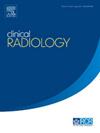Predictive ability of magnetic resonance imaging (MRI) for detecting prostate cancer and its clinical significance in MRI-targeted biopsy for prostate imaging reporting and data system (PI-RADS) ≥3 lesions
IF 1.9
3区 医学
Q2 RADIOLOGY, NUCLEAR MEDICINE & MEDICAL IMAGING
引用次数: 0
Abstract
AIM
Identifying the index lesion in prostate cancer (PCa) is vital for its treatment. Therefore, various coefficients and parameters are used to improve the diagnostic accuracy of magnetic resonance imaging (MRI). This study aimed to analyze MRI data, utilized as a triage test before prostate biopsy, to identify independent risk factors affecting negative biopsy results in PCa and investigate the ability of these factors to predict clinically significant and insignificant PCa (csPCa and ciPCa, respectively).
MATERIALS AND METHODS
A retrospective analysis was conducted on data from 364 patients with a prostate imaging reporting and data system (PI-RADS) v2.1 score of 3 or higher, who underwent cognitive MRI-targeted biopsy (MRI-TB). Of the patients, 226 (62.1%) had benign lesions, 75 (20.6%) were diagnosed with ciPCa, and 63 (17.3%) with csPCa. The study assessed patients' demographic, biochemical, and radiologic characteristics, including apparent diffusion coefficient (ADC) and ADC coefficient of variation (ADCCoV) values.
RESULTS
The multivariate analysis performed to differentiate PCa from benign pathologies revealed that only MRI parameters, specifically the presence of PI-RADS 4 and 5 lesions (odds ratio [OR]: 12, p < 0.001 and OR: 73, p = 0.008, respectively), a lower ADC value (OR: 0.996, p = 0.041) and a higher ADCCoV value (OR: 1.07, p = 0.003) were independent risk factors. No MRI findings had significant predictive power for csPCa, with total prostate-specific antigen (PSA) (OR: 1.17, p = 0.019) found to be the only independent risk factor.
CONCLUSION
The results of this study suggest that data obtained from MRI can predict PCa but not csPCa.
磁共振成像(MRI)检测前列腺癌的预测能力及其对前列腺成像报告和数据系统(PI-RADS)≥3病变的磁共振成像靶向活检的临床意义。
目的:确定前列腺癌(PCa)的指标病灶对治疗至关重要。因此,各种系数和参数被用来提高磁共振成像(MRI)的诊断准确性。本研究旨在分析前列腺活检前作为分流检查使用的磁共振成像数据,以确定影响 PCa 活检阴性结果的独立风险因素,并研究这些因素预测有临床意义和无临床意义 PCa(分别为 csPCa 和 ciPCa)的能力:对364名前列腺成像报告和数据系统(PI-RADS)v2.1评分为3分或以上、接受认知核磁共振靶向活检(MRI-TB)的患者的数据进行了回顾性分析。在这些患者中,226 人(62.1%)患有良性病变,75 人(20.6%)被诊断为 ciPCa,63 人(17.3%)被诊断为 csPCa。研究评估了患者的人口学、生化和放射学特征,包括表观弥散系数(ADC)和ADC变异系数(ADCCoV)值:为区分 PCa 和良性病变而进行的多变量分析表明,只有 MRI 参数,特别是 PI-RADS 4 和 5 病变的存在(几率比 [OR]:12,p < 0.001 和 OR:73,p = 0.008)、较低的 ADC 值(OR:0.996,p = 0.041)和较高的 ADCCoV 值(OR:1.07,p = 0.003)是独立的风险因素。磁共振成像结果对 csPCa 没有明显的预测能力,而总前列腺特异性抗原(PSA)(OR:1.17,p = 0.019)是唯一的独立风险因素:本研究结果表明,磁共振成像获得的数据可以预测 PCa,但不能预测 csPCa。
本文章由计算机程序翻译,如有差异,请以英文原文为准。
求助全文
约1分钟内获得全文
求助全文
来源期刊

Clinical radiology
医学-核医学
CiteScore
4.70
自引率
3.80%
发文量
528
审稿时长
76 days
期刊介绍:
Clinical Radiology is published by Elsevier on behalf of The Royal College of Radiologists. Clinical Radiology is an International Journal bringing you original research, editorials and review articles on all aspects of diagnostic imaging, including:
• Computed tomography
• Magnetic resonance imaging
• Ultrasonography
• Digital radiology
• Interventional radiology
• Radiography
• Nuclear medicine
Papers on radiological protection, quality assurance, audit in radiology and matters relating to radiological training and education are also included. In addition, each issue contains correspondence, book reviews and notices of forthcoming events.
 求助内容:
求助内容: 应助结果提醒方式:
应助结果提醒方式:


